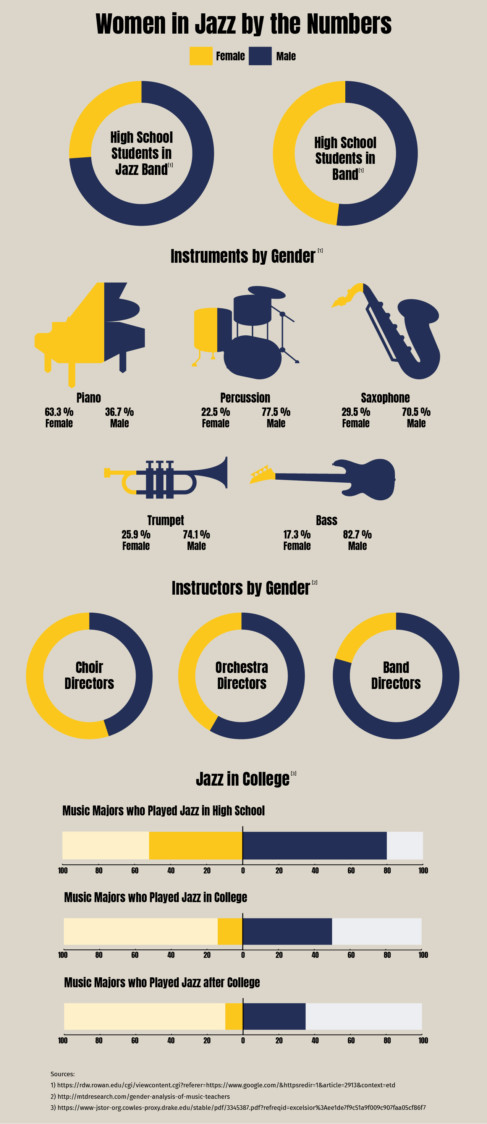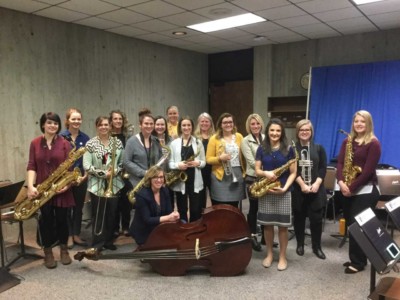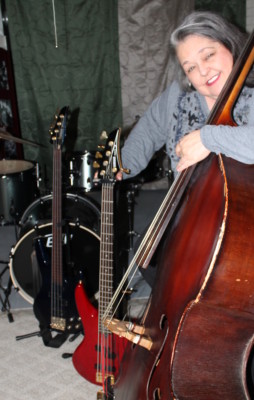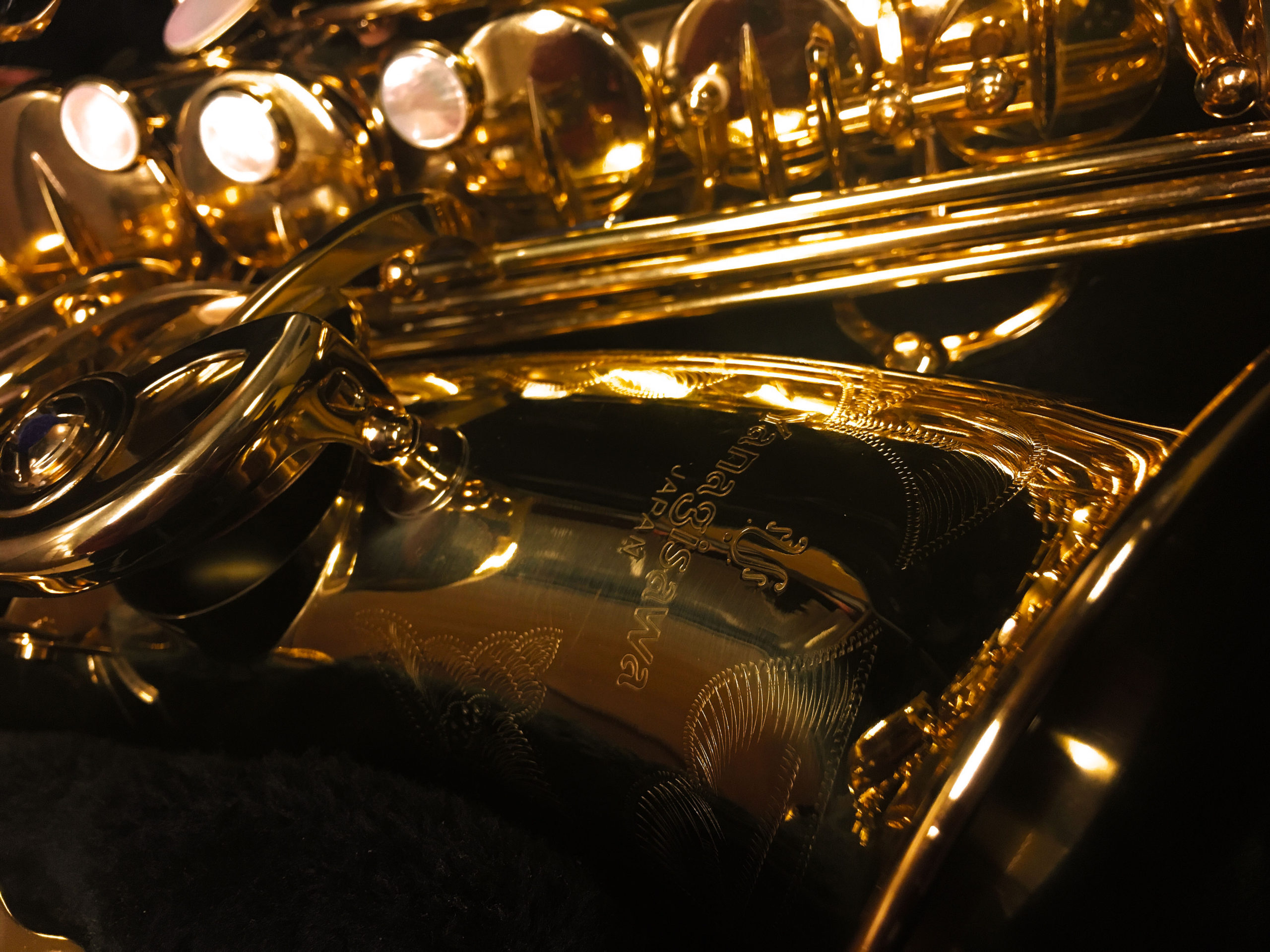When Toni LeFebvre was a young jazz trumpet player, she found herself searching online for videos of drummer Sherrie Maricle and the DIVA Jazz Orchestra, one of the few professional all-female jazz groups that has made it big, having played in places like Birdland, Carnegie Hall, Lincoln Center, and Kennedy Center.
The group was an inspiration to LeFebvre, now a music education graduate student at the University of Iowa, the only woman in the U of I’s top jazz ensemble, and one of the founders of the All-Female Jazz Orchestra of Iowa.
Modeled after groups like the DIVA Jazz Orchestra and the Seattle Women’s Jazz Orchestra, LeFebvre says the group was started “for the sake of promoting women in music and encouraging young females to find their voice in the jazz idiom.”
For varying reasons, like lack of representation and sexual harassment, there are few women in the upper echelons of the jazz world, but groups like these can help change that by showing young girls and boys that women can play jazz.
Where are the Women?
Research shows that the disparity starts as early as elementary school instrument selection.
“Women, or young girls rather, are often dissuaded from playing the trombone or the trumpet or the drums or the bass at very young ages because they have a masculine tint to them,” LeFebvre says.
In 1978, Harold F. Abeles and Susan Yank Porter published “The Sex Stereotyping of Musical Instruments,” which included a ranking of the perceived masculinity and femininity of instruments by college students. Of the main instruments in a typical big band that were ranked – saxophone, trumpet, trombone, and drums – all were ranked more masculine than feminine when compared to string instruments or woodwinds like the flute or clarinet.
In her Jazzed Magazine article, “Where are the Girls?,” Dr. Ariel Alexander, a professor at Saddleback College in California, says, “While we may question if this 1978 study is out of date, many recent researchers have explored this same area to find that over the last 30 years, the number of females playing ‘masculine’ instruments has, in fact, not changed.”
It doesn’t help that most of the great jazz instrumentalists —like Duke Ellington, Miles Davis, John Coltrane, and Count Basie — were men, or that as recent as 2015, nearly 80 percent of all high school band directors in the U.S. were men.
Men tend to be the ones teaching at the higher levels as well. According to research compiled by DATA USA, 82.5 percent of the jazz and jazz studies degrees awarded in 2016 were earned by men.
“We’ve mostly been learning from male educators,” LeFebvre says. “The people who we are asked to transcribe or play solos over the music of are always men. And I think that really affects our perception of what the possibilities are as a female … trying to be successful in jazz.”

Graphic by Brett Rosengren
There are some efforts to diversify. Michael Giles, a senior lecturer and professor of saxophone at Iowa State University, said the department of music and theatre there plans to have each ensemble program a performance of all female composers and arrangers.
While he says it’s important to shine a spotlight on women composers, this still turns female jazz composers into a novelty theme typically reserved for singular composers or musicians.
“We will maybe do a tribute to Frank Sinatra or something,” Giles says. “But just to say, ‘Hey, we’re going to do one concert and give you an hour and a half of what we think are good things by women in jazz, and that’s it,’ you know, there’s a lot of great stuff there.”
LeFebvre says representation is crucial to self-efficacy in education. In other words, students won’t feel successful when learning something new if they can’t see someone who looks like them succeeding at it.
Inspiring Young Girls

That’s where the All-Female Jazz Orchestra of Iowa comes in. Started in 2017, the group’s mission is to put an all-female big band in front of middle and high school students to serve as a role model for what female jazzers are capable of.
“We’re putting … women in front of these young students. They can see themselves in this area of music,” LeFebvre says.
The group had its first meeting at the 2017 Iowa Music Educators Association conference in Ames and has since had performances at the Iowa Bandmasters Association conference and the Dorian Middle School Summer Camp at Luther College.
“It was a blast,” says LeFebvre of the camp concert that reached over 300 middle school students.
Outside of the band, LeFebvre has also served as a high school jazz clinician, one of only a few women in the state who does so. At the end of one clinic, a girl came up to her shaking, nearly in tears, to thank her for coming. The girl’s band had never had a woman in front of them before.
“I was just totally shocked by that, and I think it’s important — if we want to support women in jazz —that we need to have a focus of introducing them to the many, many, many great women that are out there doing awesome things in the jazz world that often get overlooked,” LeFebvre says.
The women in the group represent a wide age range. Some are LeFebvre’s friends from her undergraduate time at the University of Northern Iowa, and others are local Iowan musicians and educators who have already made names for themselves in the state. The goal is to get women who are already teaching the students in front of them in a big band setting.
The Dark Deterrents

Of course lack of representation isn’t the only roadblock to women in jazz. Sexism, both inadvertent and intentional, still finds its way into jazz bands.
“I’ve had many, many instances where I’ve been told to, you know, play more masculinely,” LeFebvre says. “People don’t really say, ‘You need to play more like a man,’ but they say like, ‘Play with the balls,’ and stuff like that.”
LeFebvre is mostly able to laugh moments like those off, but they certainly don’t go unnoticed. “It’s masked by humor, rooted in sexism,” she says.
But it’s not always so innocent.
Susie Miget is an accomplished jazz bassist and singer, the founder of Creative Music Studio in West Des Moines, and the only woman to win the Jazz Educators of Iowa Hall of Fame Award. She’s had tons of experience as the only woman in the band, and while her experience has been mostly positive, she’s still had her share of uncomfortable encounters.
Most of the men in her college ensemble protected her like she was their sister or girlfriend. But there were other times when guys in the band were interested in her only because she played jazz.
“They should be interested in me that way (romantically) because of my personality and not just because I’m another jazz musician,” Miget says, “(They were) trying to find some category to put me in because I’m not one of the guys to hang out with.”
Miget also experienced sexual harassment in the classroom and on the road. Once a famous trumpet player came in to clinic the band. It was supposed to be an educational experience, but he propositioned her for sex during the clinic.
“I think he actually used that line, ‘Let’s make beautiful music together,’” Miget says.
But for her the audience members were usually worse than the musicians.
“In the club, there was this pretty well-known businessman who had had too much to drink and backed me up against the wall … pushing his genitals up against my leg, that sort of thing. Just overbearing,” Miget says.
For Miget, now in her 60s, sexual harassment just came with the territory of being a woman who worked at the time.
“I don’t think there’s a woman out there that’s my age that has not experienced that (sexual harassment) on some level,” Miget says. “But I don’t want to say that every guy that I ever played with was inappropriate or not encouraging.”
It’s different for everyone, though. Miget had a student quit jazz altogether after she was sexually assaulted on the bus with her collegiate jazz band. Miget says she thinks the student was probably the only woman in the band.
Moving Forward
Miget has also had experiences of being a role model for other women.
“I’ve had many women come up to me later and say, ‘Yeah, I saw you play at such and such a place. And I thought, ‘Boy I can do that,’’” Miget says.
Miget, LeFebvre, and Giles all say they’ve seen a modest increase in the number of high school girls and college women playing jazz over the last ten years.
“It (more women in jazz) comes through encouraging competence in women and encouraging acceptance in young men,” Miget says.
The All-Female Jazz Orchestra of Iowa hopes to play again at this year’s Iowa Bandmasters Association conference, as well as other places where they might reach their target audience of middle and high school students.
“If we can get those people that were just like me when I was in seventh grade to watch us and be inspired … that’s exactly what we need,” LeFebvre says.

